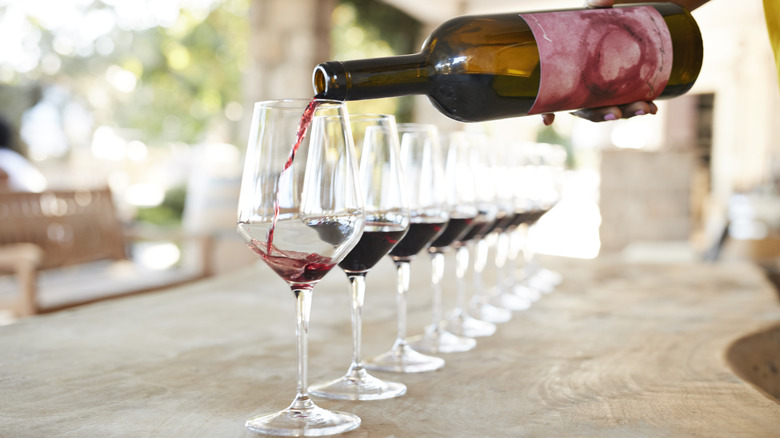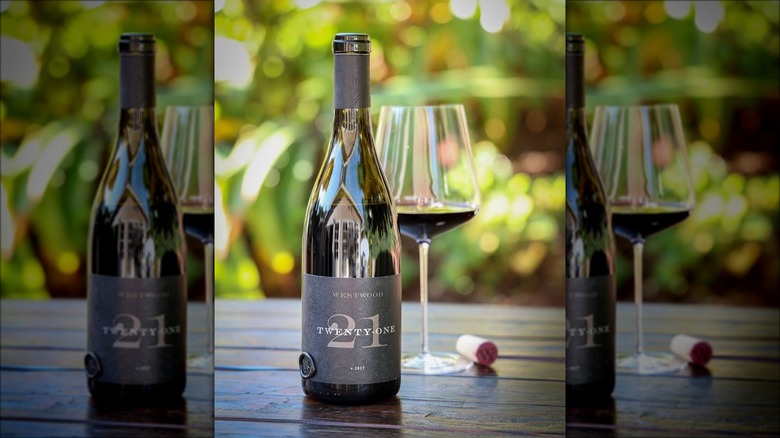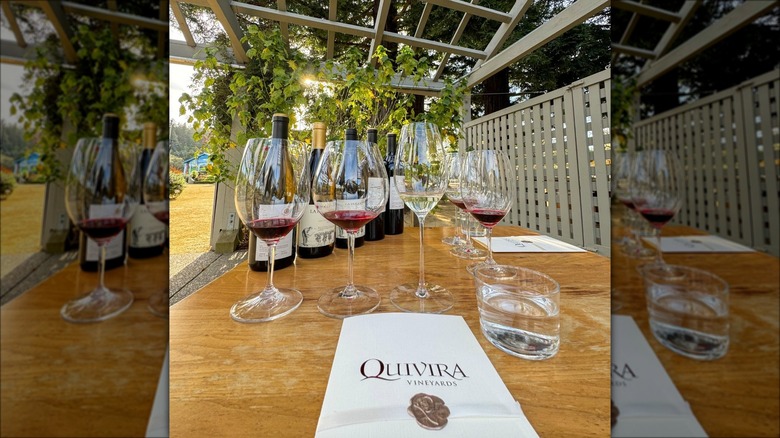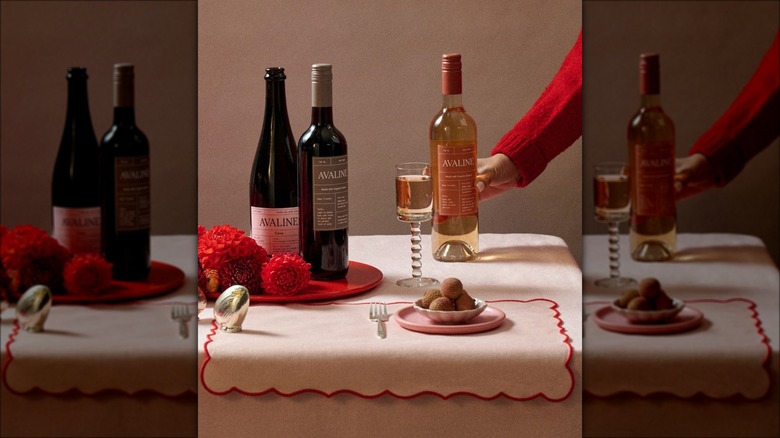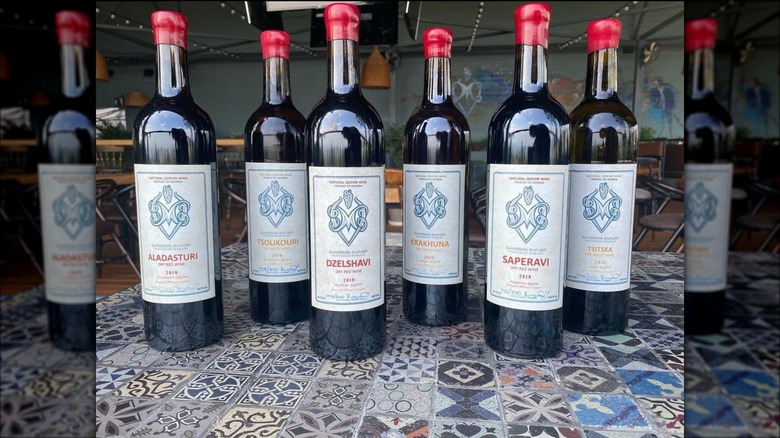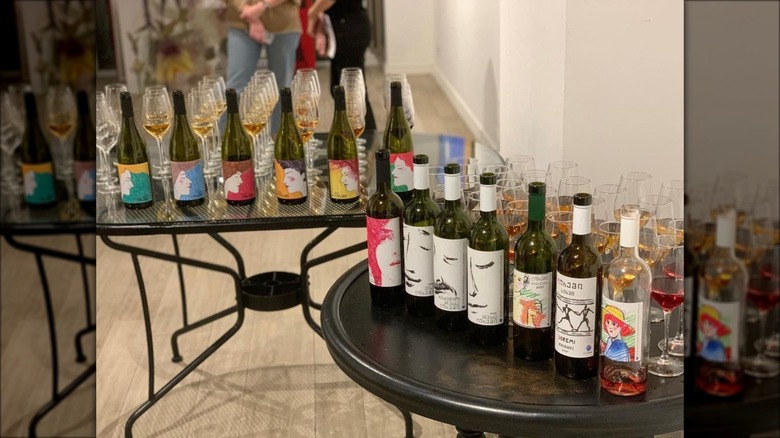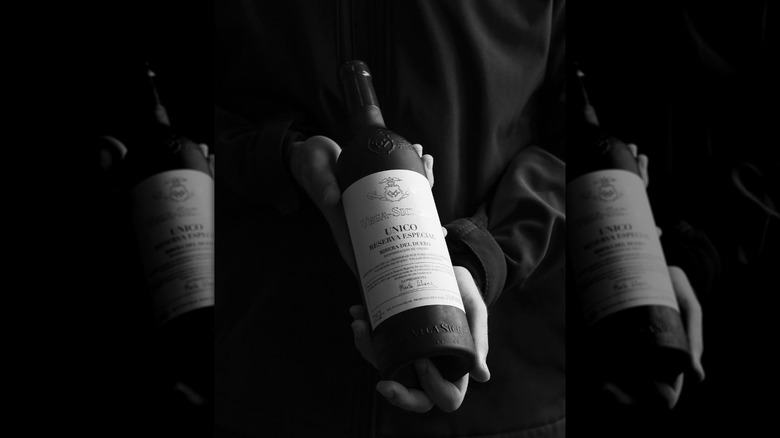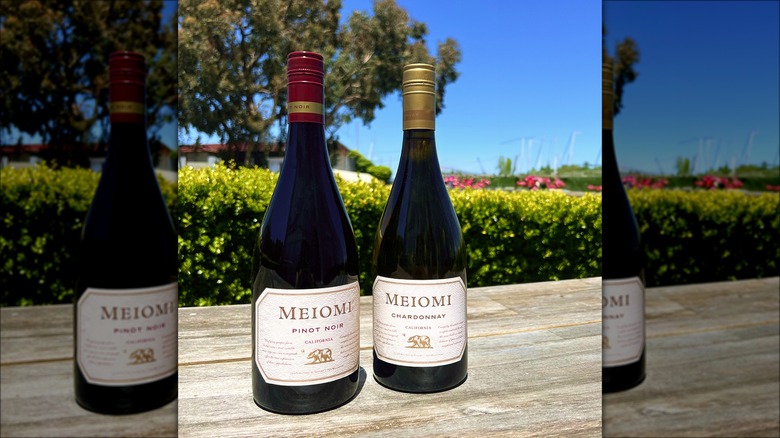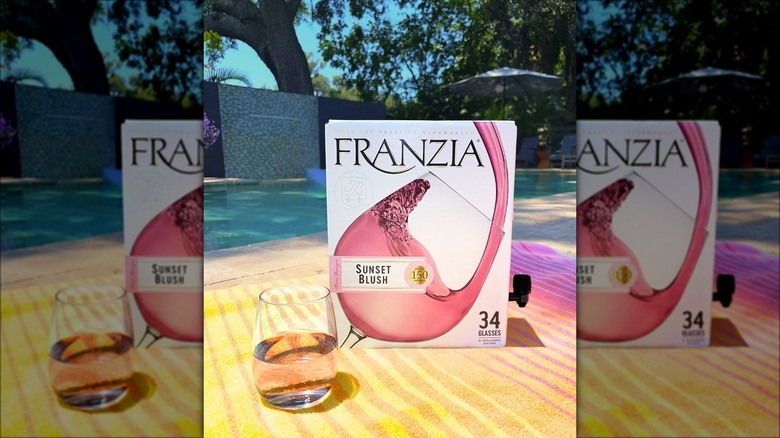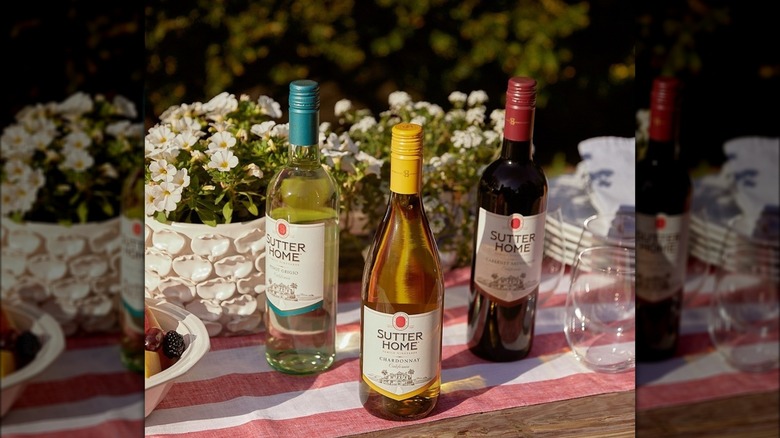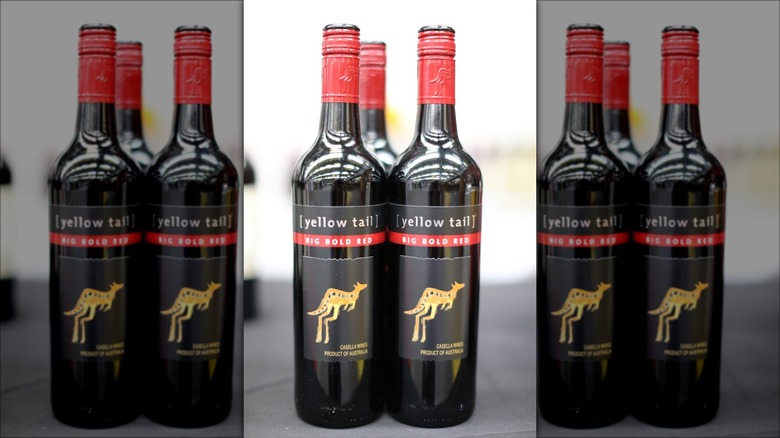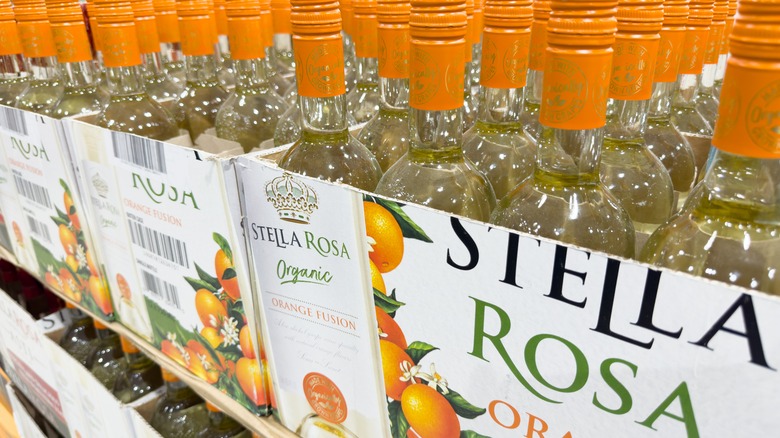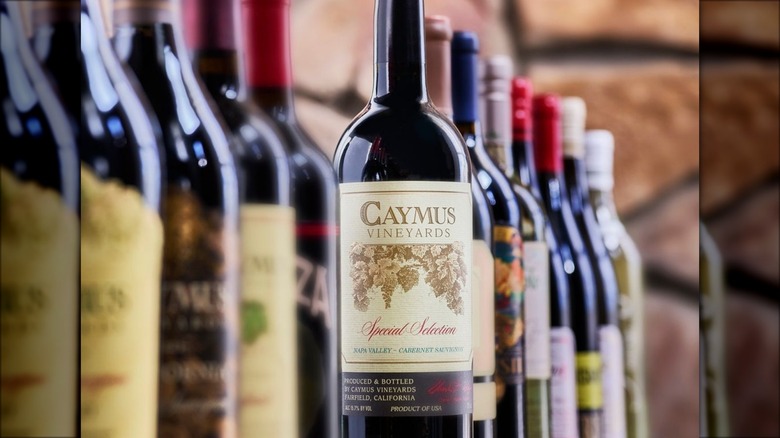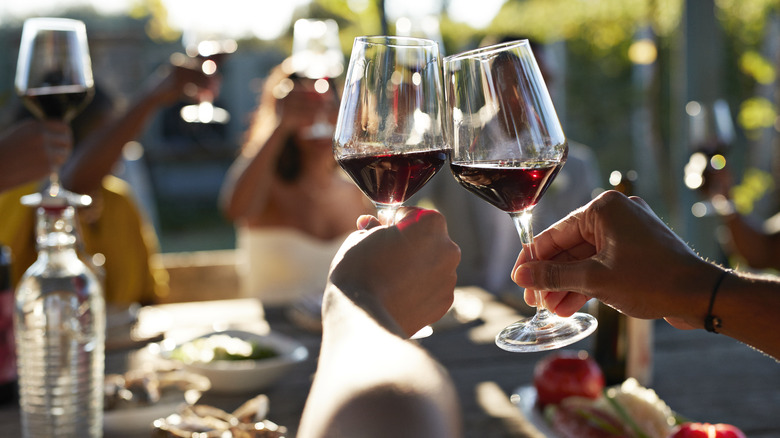Wine Brands That Use The Highest And Lowest Quality Ingredients
As a nation, we spend over $19 billion on wine per year. While wine connoisseurs have their own standards for choosing a wine, the vast majority of shoppers pick their bottle based on little more than price and personal preferences, with minimal attention paid to the actual label or the dizzying array of white wine types, red wine varieties, the ever-popular rosé, and more. However, even if you did read this label, you wouldn't glean much information about the contents of your vino.
That's because, unlike the majority of food and beverages, winemakers are not required to disclose the contents of a given bottle or nutritional information. In fact, the only thing a wine brand is legally obligated to put on this label is the alcoholic percentage of the wine in each bottle. That's despite the fact that the U.S. allows winemakers to put over 60 different additives into wines. Some of these additives are more commonplace than others; for example, the likes of various animal products have been used as fining agents in wine for centuries, like isinglass derived from fish swim bladders.
In the eyes of the experts, it's the brands using too many additives — or specific, potentially undesirable additives — that often wind up classing something as a low quality wine. But without having access to this information on the label, how do you know where which wine falls on the quality scale? We've done the research (read more about our methodology at the end) to highlight some of the higher quality wines and those that are slight letdowns on the ingredients front.
Highest: Westwood Wine
Westwood Wine is relatively new on the vino scene, having debuted in the 2010s after its founder, Carl Stanton, teamed up with established winemakers Philippe Melka and Maayan Koschitzky. The goal was to combine their expert knowledge with organic grapes that had been sustainably farmed, which they've achieved by harvesting from Annadel Gap Vineyard in the Sonoma Valley.
Squeezed in between Sonoma Mountain and Mount Hood, this vineyard gets a lot of wind — something Westwood Wine considers a blessing. Not only does this mean its grapes grow thicker skins (which it claims creates a stronger flavor) but it also creates the optimum conditions for the vineyard to farm organically and biodynamically due to the fact that it prevents mildew. Every grape grown at Annadel Gap is certified Demeter Biodynamic and CCOF Organic, meaning no pesticides or herbicides, such as glyphosate, are used on the grapes in the process. Instead, it uses "hand-made, nutrient-dense Biodynamic sprays and organic composts, all applied by hand" (via Westwood Wine). The result is high quality, flavorful grapes (and high quality, flavorful wine).
Highest: Quivira Vineyards
Quivira Vineyards hails from the depths of Northern California's wine country, where its grapes are grown across Anderson Ranch and the fittingly-named Wine Creek Ranch. Its owners, Pete and Terri Kight, are firm on a "sustainable, holistic approach" to winemaking, having been inspired by the land's previous owners, Holly and Henry Wendt, to produce "better wine through better vineyard management" (via Quivira Wine).
Today, plenty of care goes into intentionally harvesting the highest quality grapes possible for your tipple. Primarily known for its Zinfandel, Sauvignon Blanc and Rhône varieties, Quivira Vineyards only uses organic farming methods and is designated part of CCOF (California Certified Organic Farmers), meaning no synthetic pesticides or herbicides are used at any point in the winemaking process.
With a strong belief that wine is only as healthy as the land on which it grows, Quivira Vineyards pays a lot of attention to the condition of the farm in general, restoring the surrounding area and practicing thorough composting and cover crop rotation. The hope is that this TLC will transfer to the quality of the grapes — which, judging by the fact that it's a mainstay on Wine Spectator's Top 100 Wines of the World list, certainly appears to be the case.
Highest: Avaline
We'll hold up our hands and say that we judged this wine too soon. Avaline is co-owned by Cameron Diaz — yes, "There's Something About Mary" and "Shrek" actor Cameron Diaz — and celebrity alcohol brands aren't known for sitting in the top percentile quality-wise. And yet, we're pleased to say that Avaline bucks the trend.
Its website poses a very relevant question: "We knew the contents of everything that went onto and into our bodies — why not wine?" As a result, it's fairly transparent about the ingredients that go into each bottle than most of its competitors. In fact, it even lists the ingredients on said bottle, which isn't something you come across too often in the wine industry.
Whether you opt for a Sangiovese, Sauvignon Blanc, or Chardonnay, you can rest easy in knowing that every glass is "free from unwanted and undisclosed extras." That means zero concentrates, colors, or added sugars, and absolutely no producers that use synthetic pesticides. Speaking of these producers, Avaline also lists everything you could possibly want to know about those its harvesting and fermentation processes on its website, so you truly do know exactly what you're drinking.
Highest: Vartsikhe Marani
Vartsikhe Marani hails far away from the Northern California wine country that's produced many wines on this list so far. Instead, it's made in Baghdati — in the country of Georgia — where the brand uses traditional Georgian methods that date back thousands of years. It also uses grapes sourced from vineyards in both the east and west of the country. If it ain't broke, don't fix it, right?
Its founder, Kakha Tchotiashvili, comes from a long line of winemakers and oversees an incredibly straightforward production process. Vartsikhe wines are made in small but mighty batches using a qvevri — a large, handmade clay vessel into which pressed grapes and wild yeast are sealed before being buried in the ground for several months to ferment. No additives or chemicals are used during this entire process, hence why Vartsikhe is makes claims of all-natural ingredients and high quality. It also claims that wine made via qvevri is "high value of energy" and boasts special factors that "strengthen the immune system." While we're not too sure about that part, we will say that an undeniable amount of effort goes into making Vartsikhe Marani as high quality as possible.
Highest: DoReMi
Just like Vartsikhe Marani, DoReMi wines draw on centuries of tradition to try and make the best organic wine using ancient Georgian methods. Founded in 2014 by Giorgi Tsirghvava and Mamuka Tsiklauri, fermenting grapes in kvevri (as the brand spells it) is once again the modus operandi for producing spectacular wine. All grapes are harvested from biodynamic vineyards in the Kartli, Imereti and Kakheti regions of Georgia; the fruits are fermented with the skin on in those traditional handmade clay pots.
During this fermentation process, DoReMi wines use wild — not industrial — yeast. Despite the fact that it's more unpredictable than its cultivated counterpart, wild yeast has long been praised for the complexity it adds to a wine's flavor. Wild yeast also tends to contain more enzymes and bacteria, which can act as probiotics to strengthen your gut (hence why so many people prefer to use it for sourdough, too). A member of the Natural Wine Association, DoReMi also uses zero additives during its production process.
Highest: Vega Sicilia
The history of Vega Sicilia is long and impressive, with the Spanish estate and vineyards first founded in 1864 by winemaker Eloy Lecanda y Chaves. While its quality has rather infamously wavered over the years when the vineyards changed hands multiple times, things took a turn for the better in 1982 when the Álvarez family bought the estate and invested in restoring its luxurious reputation.
More than four decades later, Vega Sicilia is now regarded as some of, if not the, best wine to herald from Spain. Its most expensive wine, Unico (which quite literally means "unique" in Spanish), goes through what Vega Sicilia claims may very well be the longest aging time for a red wine (almost 10 years) before it's typically sold for over $400. In other words, that reputation for quality has more than certainly been restored. Vega Sicilia's owners have famously stringent standards, which include ditching chemical fertilizers and herbicides and even refusing to make certain wines in the years when the harvests are of unsatisfactory quality. Now that's commitment.
Lowest: Meiomi
Meiomi is another product of Northern California's wine country, with grapes grown in three of the region's biggest hotspots: Sonoma, Monterey , and Santa Barbara Counties. Pinot Noir is its bestseller, but it also offers Cabernet Sauvignon, Chardonnay, and a Red Blend, all of which retail for a respectable $22 per bottle.
But not everyone is on the Meiomi train. Critics have called out the brand for its alleged use of the additive known as Mega Purple — a thick, grape juice concentrate that's mostly sugar. Think of it as the closest thing you can get to dosing your wine with a shot of Welch's. This is the stuff that gives some red wines a deeper color and jam-like flavor and, most critically to wineries themselves, it's also extremely cheap. There's no proof that Mega Purple is especially unhealthy or dangerous, but many wine connoisseurs consider its presence a sign that a wine is of low quality (and substandard quality is something that added color and flavor can do a great job of masking).
Meiomi has never outright said that it uses Mega Purple, but multiple reports out there speculate that Mega Purple is the secret to its Pinot Noir's success. At any rate, its Pinot Noir isn't even 100% Pinot Noir. According to Wine Spectator, it's approximately 97% Pinot Noir, with small amounts of Riesling, Gewurztraminer, Chardonnay, Grenache, and other grapes added to the mix.
Lowest: Franzia
Let's preface this by saying that when it comes to boxed wine, we're not snobby. This sort of wine is generally good value, lasts longer, and — if you buy the right brand — tastes delicious. In a Mashed survey, 25% of people declared that Franzia was the best of the boxed bunch, with its affordable, colorful crates of red, white, and blush proving to be real crowd-pleasers.
We're not going to argue with the taste (because let's be real, we've never turned down a glass of Sunset Blush in our lives), but we will point out that Franzia's boxed wines don't have the best reputation when it comes to ingredients. Wine aficionados often brush off Franzia for using low quality grapes and mixing them with a bunch of other flavorings to mimic the effect of barrel aging, or to give us the sweet finish that makes the brand so popular.
A lot of its wines are made with an unspecified blend of grapes, which is likely why they come bearing vague names such as Crisp White, Chillable Red, and Dark Red Blend. As one critical Reddit user (and alleged wine salesperson) put it, "Franzia is what I like to call 'simplified,' meaning they add sugar/blend it to the point that it's more towards kool aid and less a representation of the aromas/flavor profile you come to expect from each varietal."
Lowest: Sutter Home Winery
Sutter Home Winery has roots in the 1890s, and include a time when Prohibition closed the OG winery until 1948, when the Trinchero family relocated to California and reopened the Winery, determined to get in on the state's flourishing wine industry. Today it's still owned by the Trinchero Family Estates and is the second-largest family-owned winery in the world, often credited with accidentally creating White Zinfandel.
Not all wine savants are keen on Sutter Home Winery. Producing an estimated 20 million cases per year (including production from 10 wineries in California), it's the definition of mass production, which typically requires additional concentrates, sweeteners, and flavors to maintain consistency (especially if, like in the "Sweet Red" variety, the name includes some reference to sweetness). Back in 2019, a study by the Public Interest Research Group found that the chemical glyphosate — which is commonly used in weedkiller – was present in multiple wines and beers. This included Sutter Home Winery's Merlot, which contained the highest concentration at 51 parts per billion.
Four years earlier, a lawsuit claimed that several wines made in California — Sutter Home included — contained arsenic that wasn't disclosed on the bottle, as should've been required by the labeling law Proposition 65. A study in the American Journal of Viticulture and Enology ultimately found that these arsenic concentrations weren't high enough to pose a serious hazard to adults. So, you don't really need to worry about consuming poison with your Sutter Home Moscato.
Lowest: Yellow Tail
Yellow Tail is one of Australia's most successful wine exports, selling 13.5 million cases of wine per year as of 2021 and being named the World's Most Powerful Wine Brand for six years in a row since 2018. This is thanks in no small part to its affordable price point, with Yellow Tail varieties such as Big Bold Red, Super Crisp Chardonnay, and Pure Bright Pinot Grigio retailing for as low as $5.92 per bottle.
Again, like all mass-produced wine, arguably the biggest issue with Yellow Tail is that it takes a lot of interference to create wine this consistently tasty. As Jade Palmer, wine manager of Atlanta's Hop City Craft Beer and Wine, told CNET in 2024, "The production on those has gotten so big that I don't think that the quality is there."
Seeing as how brands don't need to publish the full list of additives included in their wine, we don't know exactly which ones have been tossed into the mix. However, rumored flavor shortcuts used by Yellow Tail include oak essence, which mimics the aftertaste of barrel aging. A former winemaker at Yellow Tail also alleged to The Daily Beast back in 2009 that Mega Purple is a regular fixture of the process, too.
Lowest: Stella Rosa
It should come as no surprise that a wine brand retailing varieties such as Ruby Rosé Grapefruit, Platinum French Vanilla, and Black Cherry doesn't use the most traditional methods or ingredients. Stella Rosa has been in the business since 1917, when the Los Angeles-based Riboli family founded the San Antonio Winery and its customers reportedly requested that the establishment make a sweeter wine. Today, it more than certainly meets those consuymer demands, sourcing grapes from the Asti municipality in the Piedmont region of Italy and combining them with unique and distinctly fruity flavors.
Of course, creating flavors like these takes much more than just fermented grapes. Unlike a lot of wine brands, Stella Rosa lists its ingredients on the back of each bottle, including the likes of grape must (which is basically freshly-crushed grape juice), sugar, and natural flavors. To its credit, Stella Rose doesn't use any artificial colors or preservatives. However, if a wine is relying on added natural flavors as its main selling point, odds are that the "wine" vaguely listed amongst its ingredients isn't doing too much heavy lifting.
Lowest: Caymus Vineyards
Located in the heart of Napa Valley, Caymus Vineyards has been part of the Wagner family's diverse winery portfolio since 1972. Today, it's best known for its Cabernet Sauvignons — for which it's won Wine Spectator's "Wine of the Year" award in 1989 and 1994 — as well as small amounts of Zinfandel.
Yet Caymus Vineyards is a victim of its own success. Its critics speculate (because Caymus doesn't divulge the exact details of what goes into its wines) that its efforts to produce consistently good wine have led it to manipulate the wine through various additives, such as the infamous Mega Purple. This isn't exactly rare for big wine brands. Mainstream winemakers are believed to use mass quantities of Mega Purple every year, to the tune of thousands of gallons of the additive, which is popular not just because it boosts color, but because it lends a fruity character that masks unwanted flavors and perhaps even hints of spoiling.
As mentioned before, the presence of Mega Purple is often treated as a surefire sign of a low-quality wine. For wine aficionados on Reddit, this is why many consider it to be less than real wine as the vineyard uses, in the words of one dissatisfied poster, "Mega Purple in it to help make it a 'fruit bomb' [...] in my opinion it is a slap in the face to the many generations of vignerons and wine makers who have dedicated their lives to ethical wine making."
Methodology
In the U.S., winemakers aren't legally obliged to share the exact components of their products and over 60 additives are legally allowed to be added to wine. With that in mind, defining the wines using the highest or the lowest quality ingredients takes a lot of research.
We based our conclusions on the details available about a brand's production process, with time, effort, and lack of shortcuts often being what set the high quality wines apart. We also delved into reports and claims within the wine scene about the amount and type of additives used in each brand's bottles. Some, such as Mega Purple, were an immediate red flag, signifying that a brand extensively manipulates its products beyond traditional winemaking techniques. Other details we considered to mark out low quality included the use of additional sweeteners or sugar, as well as any notable controversies around certain ingredients or contaminants.
